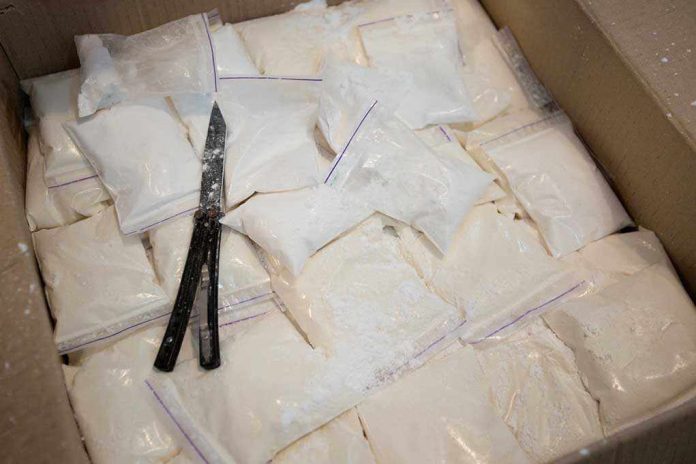
Colombian drug cartels are revolutionizing their smuggling methods with unmanned submarines controlled by Elon Musk’s Starlink technology, marking a dangerous technological leap in narcotics trafficking that threatens to make illegal drug shipments virtually untraceable.
Key Takeaways
- The Colombian Navy seized its first unmanned narco-submarine equipped with Starlink technology, capable of carrying 1.5 tonnes of cocaine
- The vessel was empty, believed to be a trial run by the Gulf Clan, Colombia’s largest drug trafficking organization
- This technological advancement allows cartels to operate vessels remotely, eliminating the risk of captured crew members cooperating with authorities
- Drug trafficking organizations are increasingly using sophisticated technology to evade detection and operate with partial autonomy
- 2024 has seen a near-record number of narco-submarine interceptions as cartels expand their oceanic reach
Starlink-Powered Narco Submarines: A Troubling Evolution
In a significant development that signals the growing technological sophistication of drug cartels, the Colombian Navy recently intercepted an unmanned submarine equipped with Starlink satellite technology off the country’s Caribbean coast. The vessel, which authorities believe belongs to the Gulf Clan, Colombia’s largest drug trafficking organization, represents a dangerous evolution in smuggling tactics. Although the submarine was empty when seized, naval authorities confirmed it was likely undergoing testing before being deployed for actual drug transportation operations with a capacity to transport approximately 1.5 tonnes of cocaine.
The Colombian navy on Wednesday announced its first seizure of an unmanned narco-submarine equipped with a Starlink antenna off its Caribbean coast https://t.co/bxuSLPbvjd
— Insider Paper (@TheInsiderPaper) July 2, 2025
“It was being tested and was empty,” explained a naval spokeswoman, adding that the navy “was still studying how exactly it operated.” This marks the first reported discovery of a drone narco-submarine in South American waters, although intelligence reports suggest Mexican cartels have been developing this technology since at least 2017. The vessel’s integration of Starlink technology provides reliable internet connectivity in remote ocean areas, enabling precise remote control capabilities that would have been impossible just a few years ago.
The Colombian navy on Wednesday announced its first seizure of an unmanned narco-submarine equipped with a Starlink antenna off its Caribbean coast https://t.co/bxuSLPbvjd
— Insider Paper (@TheInsiderPaper) July 2, 2025
The Strategic Advantage of Unmanned Drug Vessels
The transition to unmanned vessels represents a calculated strategic shift by drug trafficking organizations to minimize risk and maximize operational security. Traditional narco-submarines typically require crews of three to four people who face significant dangers, including potential death from engine fumes in the cramped, poorly ventilated vessels. More importantly for cartel leaders, captured crew members often become valuable intelligence sources for authorities, leading to the identification and prosecution of higher-level operatives in the trafficking organizations.
“Removing the crew eliminates the risk of captured operators cooperating with authorities,” noted Henry Shuldiner, a drug trafficking expert quoted in France24’s reporting.
The Colombian military has observed what Admiral Juan Ricardo Rozo describes as a “migration toward more sophisticated unmanned systems” that are increasingly difficult to detect and intercept. This technological advancement comes as cocaine production and trafficking reach historic highs, with Colombia’s production at record levels driven by seemingly insatiable global demand. The country’s law enforcement faces an uphill battle, despite imposing penalties of up to 14 years in prison for involvement with semi-submersibles.
Expanding Range and Capabilities
Perhaps most concerning for international drug enforcement agencies is the expanded operational range these technologically advanced vessels provide. While traditional narco-submarines typically traveled from Colombia to Central America or Mexico, recent years have seen these vessels crossing oceans. Last year, authorities intercepted a semi-submersible carrying five tons of cocaine en route to Australia, demonstrating the global reach cartels now possess. The addition of Starlink technology potentially enables these vessels to maintain reliable communication and navigation capabilities across vast distances.
“The Gulf Clan hired technology experts and engineers to develop an unmanned submarine,” reported Juana Cabezas, a security analyst.
This isn’t the first time Starlink has been implicated in drug trafficking operations. Previous cases have documented the technology’s use in coordinating methamphetamine shipments near the Andaman and Nicobar islands. As cartels continue investing in cutting-edge technology and engineering expertise, law enforcement agencies face increasingly sophisticated adversaries who can operate with greater stealth, range, and operational security than ever before, potentially allowing more drugs to reach American streets while making it harder to identify and prosecute those responsible.







